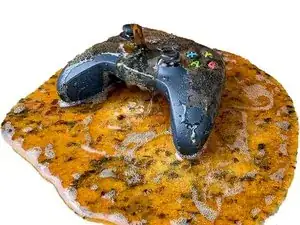The third revision of the Xbox Wireless Controller was released in November 2020, bundled with Xbox Series X and Series S. It is backward compatible with existing Xbox One consoles. While this controller works on legacy consoles, the new Share button may not work; this will just remain unused when unsupported.
The controller supports Bluetooth Low Energy and can simultaneously be paired to a Bluetooth device and an Xbox. The controller also includes Dynamic Latency Input, sending controller information to the console more frequently and in time with the current framerate to reduce the latency between user input and reaction in the game.
In September 2021 through the Xbox Insider program, Microsoft started rolling out the improved Bluetooth and latency features from these newer controllers to its official Xbox One controllers, including the Xbox Adaptive Controller.
The Series X|S controller has a slightly smaller body, but some prominent features to separate it from Xbox One controllers are:
- The "Share" button on the center of the controller, below the "View" and "Menu" buttons
- Circular dished D-pad similar to that of the Elite Controller
- USB-C connector instead of USB Micro-B.
- BEWARE: While this port eliminates a chronic point of failure, it may break support for accessories that use the USB port unless an adapter can be used for these accessories.
Shared features between models 1537, 1697, 1708, and 1914 include:
- The Start and Back buttons found on the 360 controllers have been replaced with the Menu and View buttons, respectively.
- The triggers on the Xbox One controller have been mounted with individual rumble motors to enhance the gaming experience.
- The Xbox button now glows white when the controller is switched on.
- The X, Y, B, and A buttons are the only colored parts of the controller.
- USB port to connect to a PC or console - pre-1914 controllers use a MicroUSB port, while the 1914 controller uses USB-C.
Shared features between models 1708 and 1914:
- Model 1708 and 1914 controllers feature an integrated 3.5mm headphone jack (software controlled). However, compatibility is limited to the CTIA/AHJ standard.
- Users with headsets that do not use this standard will still need the headset adapter. However, this is less of a problem now that most newer headsets use the CTIA/AHJ standard.
- The back plastic on the controller has a different back texture compared to the outgoing Model 1708 controller.
- The front faceplate moves the X button cover to the faceplate. The plastic cover previously used has been size reduced and only covers the controller sync button.
- As with all Xbox controllers, there are multiple color options. The most common colors are white and black, with special edition colors and Xbox Design Lab options for an additional $20.
Dimensions & weight
Connectivity
- 3.5 mm headset jack for headsets with or without a microphone
- USB-C port for charging, wired gameplay, and accessories
- Wireless connectivity via Xbox Wireless Adapter (Windows 10/11 PC) or Bluetooth LE (Windows 10/11 PC, iOS, Android), or USB-C (Wired).
Battery
Buttons
- 2x thumbsticks (potentiometers)
- Directional pad
- 4x main face buttons (ABXY)
- 2x shoulder buttons
- 2x triggers
- Xbox button
- Start and Select buttons
- Share button
Colors
- Black, White, Blue, Red, Volt, Pink, Green
Additional Features
- Textured triggers and bumpers
- Wireless Xbox X|S bluetooth connection via Linux (Ubuntu 22.04+).
- Ubuntu claims the controller is connected, but controller keeps flashing?
- Boot up an actual Windows machine (I found out the hard way). Don't update through a Windows VM.
- Either update via a Windows machine, or if you have Windows on an external storage medium, F key into it and update your controller.
- After the controller has been updated, your controller will work as it always does. Toggle the "forget this device" when you want to reconnect.
